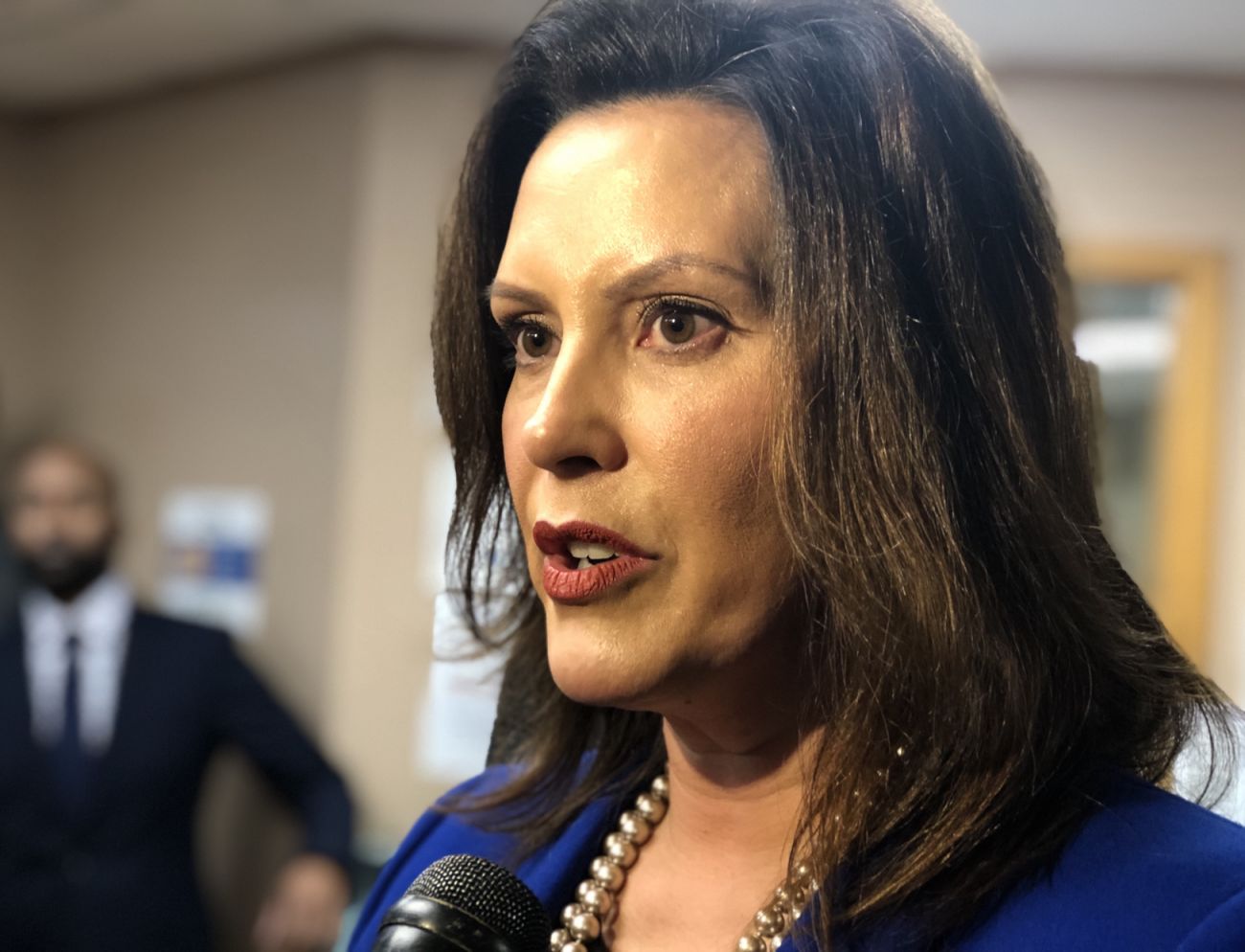Michigan’s $6.2B coronavirus budget gap ‘as bad or worse’ than Great Recession

LANSING — Michigan lawmakers need to dramatically slash spending, raise taxes or hope for a federal bailout to offset a projected $3.2 billion shortfall and balance next year’s budget despite what could be another $3 billion loss because of the coronavirus pandemic.
That’s the word from state budget officials, who on Friday warned that tax collections not only are plummeting amid the coronavirus pandemic, but welfare spending will significantly increase as more residents lose their jobs.
“To say the numbers we just saw are sobering would be an understatement,” Michigan Budget Director Chris Kolb said Friday after a bi-annual consensus revenue estimating conference, where officials lowered projected tax collections by $6.2 billion over the next 18 months, more than wiping out what little growth they had previously expected.
- The latest: Michigan coronavirus map, curve, chart, updated COVID-19 news
- Gov. Whitmer extends Michigan coronavirus stay-at-home order to May 28
- Whitmer reopens Michigan from coronavirus in phases: What that means to you
“There’s no playbook that’s on the shelf to truly address a loss of revenue of this size this quickly. This is potentially as bad, if not worse than, the Great Recession.”
The state may not be able to delay tough budget decisions for long.
In the current fiscal year, which runs through August, Michigan is expected to lose $1.9 billion in expected revenue from what would have been an $11 billion general fund and $1.2 billion from what would have been a $13.9 billion school aid fund.
Michigan’s current-year budget was built on an assumption that a combined $24.9 billion in revenue would flow into those funds by October, but officials now expect closer to $21.7 billion.
That 13 percent reduction is twice the size of the state’s largest one-time revenue loss during the Great Recession in 2009.
Officials have roughly $700 million in unspent money they can allocate and will also consider tapping what is now a $1.2 billion “rainy day” fund designed for use in fiscal emergencies.
Even then, the state is expected to face a significant budget hole this year, along with $3 billion less than expected to build a 2021 budget that must be balanced by October 1, as required by the Michigan Constitution.
As a point of reference, Kolb said that eliminating 12 of the state’s smaller departments — including the entire budget for the Legislature and the judiciary — would save the state less than $2 billion.
Republicans who control the Legislature urged Gov. Gretchen Whitmer, a Democrat, to release a new 2021 budget proposal and begin negotiations on current-year cuts.
“We have a massive revenue shortfall brought on by this economic shutdown that will affect our families, schools, local governments and vulnerable citizens,” said Rep. Shane Hernandez, R-Port Huron, chair of the House Appropriations Committee.
“The people need to hear from the governor what her priorities are that reflect this new reality facing our state. Time is of the essence and we look forward to resolving this challenge.”
Sen. Wayne Schmidt, a Traverse City Republican who chairs the K-12 school budget committee, has warned that state revenue losses could force up to a 25 recent funding cut for Michigan schools next fiscal year.
But revenue projections announced Friday put the possible cut at closer to $650 per-pupil this year. The average district in Michigan receives about $8,000 per student.
Whitmer has made clear that public education will remain one of her top priorities, but Kolb stopped short of promising to spare K-12 schools from cuts.
“We’re going to work to really protect the priorities of health, education, and public safety here in Michigan,” Kolb said. “There will be hard decisions to make, but we’re going to take the harshness of those hard decisions off.”
Speaking to reporters at a separate press conference Friday, Whitmer said that she is "not going to go into what all the possibilities are" for what cuts are possible. But she added that states nationwide face similar "grim" budget shortfalls and urged Congress to provide help.
The federal government has provided Michigan with roughly $3 billion to spend on the coronavirus response, but the relief package approved by Congress does not allow the state to use that money to backfill related budget gaps.
Nationally, state and local government leaders are calling on Congress to approve more funding or at least provide more flexibility to use the previously allocated money.
The state has only limited authority to borrow money without voter approval, said Treasurer Rachel Eubanks.
“The existing tools the state has for bonding are not useful in this crisis,” she said.
Some numbers to illustrate the crisis:
- Collections from Michigan’s 6 percent sales tax are projected to fall from $8.25 billion in 2019 to $7.5 billion this year and $7.9 billion in 2021.
- Business taxes are projected to drop from $770 million in 2019 to roughly $300 million in both 2020 and 2021.
- Collections from the state’s 4.25 percent income tax are expected to fall from $10.43 billion last year to less than $9.4 billion this fiscal year and $9.5 billion in 2021. Those would be the smallest collections since 2014.
- Michigan’s gross domestic product, a measurement of the total value of goods and services provided in the state, is projected to drop by between 24.5 percent and 32.8 percent in the second quarter of 2020 before rebounding in the latter half of the year, according to state officials. That would be a larger quarterly drop than in any of the state’s last five recessions, including the 8.4 percent quarterly reduction recorded in the fourth quarter of 2008.
“We hear all the time that this is unprecedented and uncharted territory,” said Jim Stansell, chief economist for the House Fiscal Agency. “It’s absolutely true.”
At the same time, state officials predict major jumps in welfare and Medicaid health insurance programs because of the economic recession.
The Senate Fiscal Agency predicts 7,000 new families will qualify for cash assistance this year, and then another 13,000 in 2021.
The agency projects some 600,000 new Medicaid enrollees over the next two years, moving the state towards 2.85 million participants by the end of 2021, which would “definitely be record numbers,” said fiscal analyst Steven Angelotti.
Michigan will save an estimated $138 million on public assistance programs this year because the federal government temporarily increased its Medicaid match rate, but state costs are expected to climb by $569 million in 2021 and $302 million in 2022.
Massive unemployment, quick rebound
The budget projections come as Republicans lawmakers urge Whitmer to accelerate her business reopening plan amid the ongoing but slowing pandemic, which had killed 4,825 residents as of Friday.
More than 1.7 million Michiganders have filed for unemployment insurance benefits since mid-March, and roughly 1.4 million have qualified.
Critics contend Whitmer has exacerbated Michigan’s economic downturn by maintaining a stricter stay-at-home order than most states, but national restaurant booking and consumer spending data show rebounds are not happening at a dramatically faster rate in states like Georgia and South Carolina that were quicker to reopen, according to University of Michigan economist Gabriel Ehrlich.
That suggests health-driven decisions by private residents and business owners — not just government mandates — fuel the downturn, he told officials during the consensus revenue estimating conference.
“The substantial majority is coming from private changes in behavior that would be going on even without the government restrictions,” Ehrlich said.
While states across the country are beginning to relax regulations, “service industries with high perceived threats of infection will not rebound until customers feel safe,” said Daniil Manaenkov, another U-M economist.
Spending at sit-down restaurants, air travel, public transportation and sporting events may not “go back to normal anytime soon,” he said.
The U-M economists project Michigan will hit a peak unemployment rate of 22 percent this quarter. That would top the highest level during the Great Recession and exceed the projected national rate of 17.4 percent, reflecting the state’s economic reliance on the auto industry and its relatively high COVID-19 case count.
But the economists expect a fairly fast recovery because most layoffs caused by the pandemic appear temporary in nature.
U-M projects 650,000 job recoveries in the second half of 2020 and 236,000 in 2021.
Ehrlich said those projections are built on “optimistic assumptions” that Michigan will not see a major second wave of COVID-19 and the federal government will provide state and local government with a collective $600 billion in aid over the next two years.
If that happens, the U-M economists predict nine out of every ten Michigan residents who lost their job during the pandemic will likely be employed again by the end of 2022.
A recent Michigan survey showed 1 in 7 small businesses do not think they will survive the shutdown, and about 4.9 percent of Michigan workers are employed by those firms, they said.
Despite mass layoffs, U-M economists estimate personal incomes will remain relatively stable because of temporary boosts in unemployment insurance benefits, including a $600 per week stipend authorized by the federal government, and other assistance programs.
If everyone who should be able to qualify does, Michigan residents could still collectively earn about 99 percent of their base earnings from 2019.
Still, reduced consumer confidence and business closures is expected to drive down light vehicle sales this year. Automakers sold 16.9 million light vehicle sales in the United States in 2019 but are only expected to sell 13.3 million this year, 15.2 million in 2021 and 15.8 million in 2022, according to U-M projections.
Whitmer allowed manufacturers to return to work this week, and Detroit automakers will resume production at most facilities Monday. But suppliers that operate with “very thin margins” could still see a “drain on cash” if they reopen with only one worker shift and still face the threat of insolvency, said Kristin Dziczek of the Center for Automotive Research in Ann Arbor.
She predicted Detroit automakers will produce 2.3 million fewer light vehicles this year than they did in 2019.
“We’re very concerned about the health of this industry and the continued ability of suppliers in particular to have financial support until they get back up to full production,” Dziczek said. “We’re going to be in a period of distress for a few years.”
— Reporter Riley Beggin contributed
See what new members are saying about why they donated to Bridge Michigan:
- “In order for this information to be accurate and unbiased it must be underwritten by its readers, not by special interests.” - Larry S.
- “Not many other media sources report on the topics Bridge does.” - Susan B.
- “Your journalism is outstanding and rare these days.” - Mark S.
If you want to ensure the future of nonpartisan, nonprofit Michigan journalism, please become a member today. You, too, will be asked why you donated and maybe we'll feature your quote next time!




